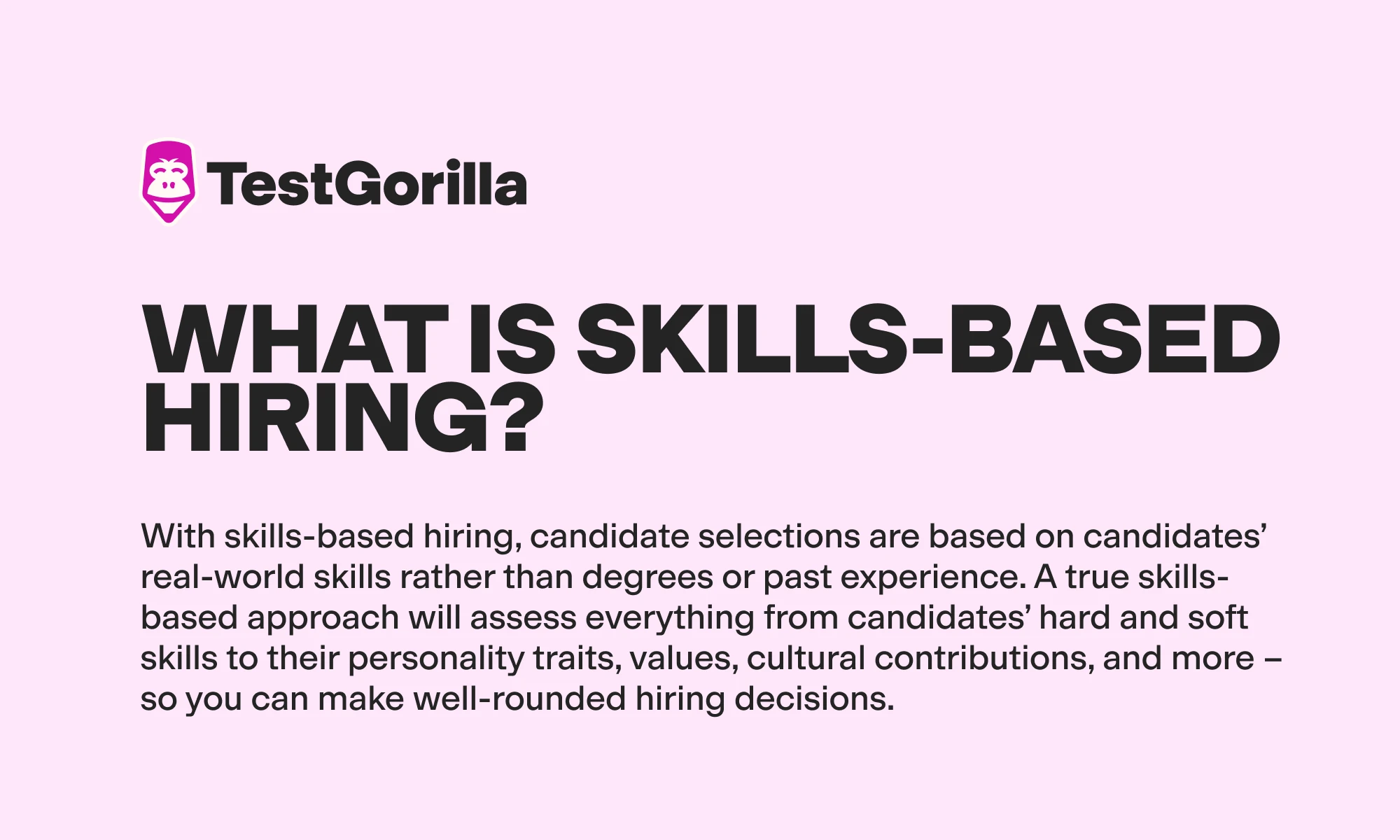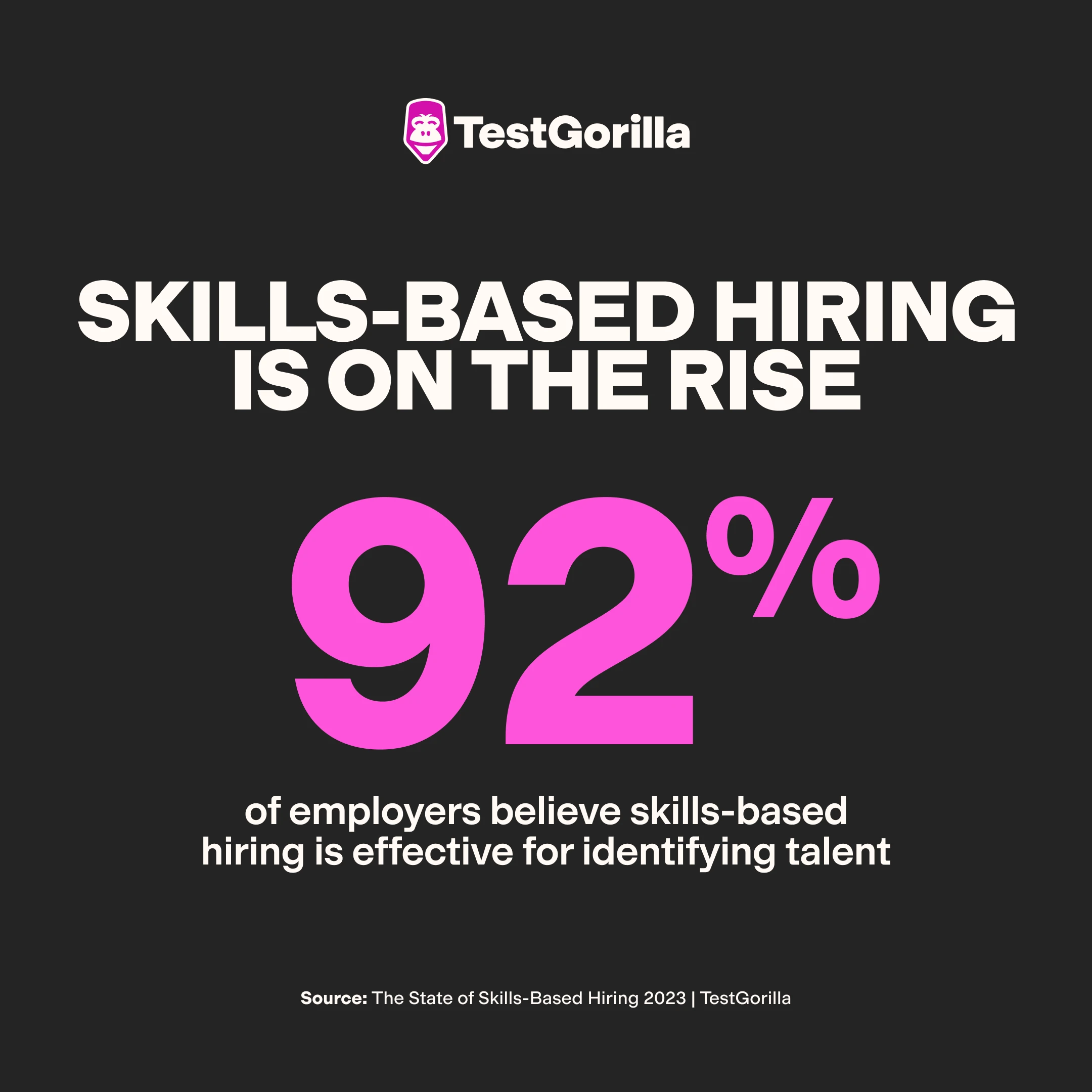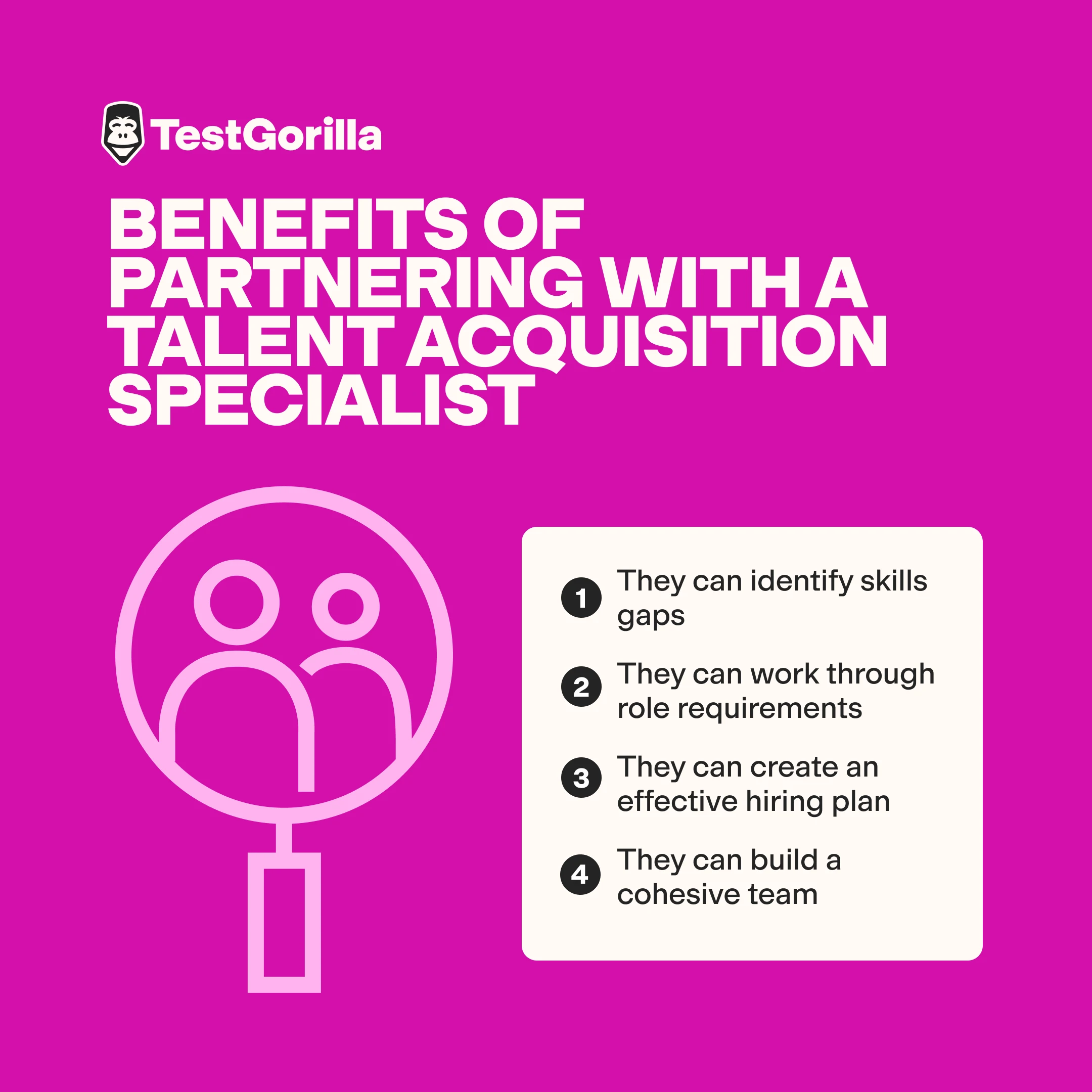Reinventing talent acquisition could create a pathway to skills-based hiring
As the hiring landscape becomes increasingly complex, more employers are turning to skills-based hiring. This approach isn't just a trend – it's a strategy proven to improve hiring, cut costs, and reduce employers’ time to hire.
Yet, despite the obvious benefits, many companies that genuinely desire improvement – perhaps yours – continue to fall short. The root of the problem? You might be clinging to outdated practices, failing to innovate, and undervaluing what your talent acquisition team can bring to the table.
If you feel like you're stuck in the mud, don't worry – we can help. In this article, we explore why changing how you think about talent acquisition is the first step towards transforming your hiring processes and landing top-tier talent for your company.
Table of contents
Stepping back: What’s all this fuss around skills-based hiring?
Before we go on, let’s recap what skills-based hiring is and why it’s the approach of choice in modern recruitment.
What is skills-based hiring?
With skills-based hiring, candidate selections are based on candidates’ real-world skills rather than degrees or past experience. A true skills-based approach will assess everything from candidates’ hard and soft skills to their personality traits, values, cultural contributions, and more – so you can make well-rounded hiring decisions.
According to The State of Skills-Based Hiring 2024, 82% of 25-34 year olds prefer a skills-based hiring process
Skills tests, case studies, simulations, structured interviews, or other processes that help you evaluate your candidates’ current skills form part of this approach.
Why is skills-based hiring on the rise?
Here’s why more employers are looking to adopt skills-based hiring today.
1. It narrows the skills discovery gap
The post-pandemic years saw tight labor market conditions with more open positions than skilled labor to fill them.
However, a recent report by SHRM suggests that labor markets have started cooling due to layoffs in the tech sector, a rise in unemployment, and stabilizing wages. Technically, this means it should be easier to find candidates, as there’s more talent looking actively for work.
Despite this, 58% of companies still believe they’re victims of skills shortages. So, what’s happening here?
We believe the issue isn’t a skills gap but rather a discovery gap. Employers just can’t find or secure talented individuals for their companies. Much of this stems from ineffective hiring processes, lack of access to good talent, and biases that narrow their candidate pool – all which can be solved by switching to a skills-based hiring approach.
Where’s the proof? We surveyed 1,500 employers in 2023 and found that 92% believe skills-based hiring is effective for identifying talent.
2. It leads to more diversity
Over time, more companies believe that a diverse workforce leads to better business outcomes. Moreover, the next generation of workers values diversity and wants to work for companies that prioritize it.
In fact, a recent report suggested that 56% of Gen Z-ers wouldn’t accept a job without diverse leadership, and 68% felt their employers weren’t doing enough to build a diverse workplace.
Skills-based hiring removes the need for degrees – which are often less accessible to certain minority groups. This lets you tap into a wider and more diverse candidate pool and gives everyone a fair chance to prove themselves.
Additionally, using objective tools like skills tests helps eliminate some of the biases found in hiring, enabling you to make fair decisions and select skilled applicants from all walks of life. Our research showed that 84% of employers using skills-based hiring saw a positive impact on diversity, while 22.5% reported a very large impact.
3. It’s rooted in data, not assumptions
Today, every company recognizes the importance of using data to drive decisions, including in recruitment.
Skills-based hiring methods like talent assessments provide you with hard data about a candidate’s abilities. So, you don’t rely on assumptions you make from screening their resumes. This not only makes it quicker and easier to screen applicants but also ensures you’re short-listing only those who have what it takes to succeed.
In a 2024 survey we ran with 1000+ employers, 90% of employers claimed that skills-based hiring actually reduced instances of mis-hiring in their companies.
Cutting the BS: Employers aren’t truly hiring for skills yet…
With all this in mind, it’s no surprise employers want to hire for skills. Recent data suggests that many companies and some state governments have openly expressed a desire to eliminate the need for college degrees from their job postings.
However, the reality of the situation is very different.
The Burning Glass Institute recently published a report showing that despite removing degree requirements from job listings, 45% of employers have made no real change in how they hire. Shockingly, only one in 700 applicants benefitted from a truly skills-based approach.
A recent article also showed that while skills-based hiring is a top priority, many employers find implementing it difficult. At TestGorilla, we believe the single biggest reason for this is that they haven’t made any real change to their ideas around talent acquisition or their hiring processes.
How traditional talent acquisition is stunting skills-based hiring
When it comes to talent acquisition, here’s how obsolete practices are holding you back from embracing skills-based hiring.
Narrow-minded views of talent acquisition
Many companies are still clinging to the old-fashioned idea that talent acquisition is a purely administrative department that posts jobs, screens resumes, schedules interviews, and manages paperwork. They don’t involve their talent acquisition team early on the hiring process and miss out on the tremendous value good recruiters can add.
Research by the Josh Bersin Company and AMS found that just 32% of talent acquisition leaders feel like strategic partners at their organizations. One leader said, “We are considered a low-cost fulfillment center, and that’s not the value we provide.”
And a recent blog post by Josh Bersin discussing this research pointed out –
“Talent acquisition leaders (this is a senior position) are largely left out of their company’s strategic planning process and many feel they operate as “order takers.”
Here’s how this lack of talent acquisition involvement often plays out at companies:
Some company leaders and hiring managers pick the role they want to hire for, list what they need – a computer science degree, for instance – and determine a salary. They do this all before getting recruitment involved.
With no chance to contribute, the talent acquisition team has to make assumptions about information or waste time with back-and-forths. Plus, they’re not empowered to make decisions – such as sourcing non-degreed candidates skilled through alternative routes – which often leads to poor-quality hiring.
Biased job descriptions
Traditionally, most job descriptions listed the degrees and years of experience “needed” for a job. Many companies haven’t changed this – their job descriptions still don’t reflect the skills and capabilities required for success.
Those still using this outdated approach could lose out on great candidates who have the right skills but lack the specified academic background or direct experience.
Further, in addition to citing unnecessary qualifications, job descriptions might also be susceptible to using biased language. For instance, terms like “young” or “digital native” can alienate older candidates, while gender-coded words like “ninja” might deter female applicants – resulting in poorer diversity outcomes for the company. This means that skilled candidates might not even bother applying.
Reliance on conventional sourcing methods
Recent research showed that US employers are now less enamored with hiring graduates from Ivy League universities. But it’s not all good news. Instead of moving away from college-based hiring entirely, 42% of employers said they’re more likely to hire graduates from public universities, while 37% said the same for top private colleges.
Employers are still relying on campus hiring to source entry-level talent, which is problematic. Research discussed in the Harvard Business Review found that degrees don’t predict job performance. Further, by hiring from specific college campuses, you’re losing out on many top candidates from other colleges or those skilled through other means.
In addition to college hiring, most top employers still post their open positions only on popular job boards like LinkedIn. These job boards widen your reach, but a big talent pool doesn’t mean a skilled pool. By sticking to generic job boards, you could miss out on hidden gems available on niche job boards, social media communities, and more.
Continued obsession with resumes as screening tools
We found that over 70% of employers now incorporate skills-based hiring into their talent acquisition processes – definitely a step in the right direction. However, most of these employers are still using resumes and cover letters to screen candidates despite this being time-consuming, perpetuating biases, and taking away from a truly fair, skills-based process.
For example, coming across a candidate from a top college might tempt you into giving them a chance, even if they don’t have the right skills for the job. Similarly, you could pick unqualified applicants who have the same interests and hobbies as you – while missing out on skilled candidates whose resumes weren’t as appealing.
One-dimensional hiring
It’s common for employers to hire applicants based on only their credentials or technical abilities to perform their tasks.
But even the most talented candidates will fail in their roles if they can’t mesh with their team or integrate into the company’s culture and working practices. Employers who neglect to check their candidates' soft skills, personalities, values, etc. are still prone to mis-hiring.
Too many cooks
Historically, talent acquisition has always been a largely bureaucratic process with multiple decision-makers at each stage of the application process. Hiring manager must approve credentials, several decision-makers may interview shortlisted candidates, and more.
Not only is this process time-consuming and capable of turning away quality candidates, but it also presents more opportunities for decision-makers not invested in skills-based hiring to disempower talent acquisition teams and make choices that oppose skills-based principles.
How to transform talent acquisition
Empower your talent acquisition team by viewing them as more than just a staffing department. Partner with them to map out your company’s skills inventory, identify skills gaps, understand the hiring landscape, and pave the way using a skills-based approach.
Consider the below strategies to shake things up and reinvent talent acquisition in your company.
Partner with talent acquisition outside of active hiring
Start viewing your talent acquisition team as strategic partners of the business rather than an admin department you need only when you’re looking to hire.
For instance, they can work with you to create your company’s skills ontology, which involves mapping out all the skills within your company, classifying them, and understanding how they relate to each other.
With their deep knowledge of your company’s objectives and labor market conditions, your talent acquisition team can spot trends, identify gaps, and keep things updated.
Further, they can help build the talent pipeline. For example, if you’re pivoting to include more AI in the next six months, recruiters can begin targeting candidates with the specific AI skills you’re looking for long before you launch your first AI product.
This way, you’re always prepared to adapt to business needs or market changes.
Give them a seat at the table
Ensure your talent acquisition team is up to speed with your company’s long-term goals so your recruitment activities align with your business objectives.
Here’s what a good talent acquisition specialist can bring to the table.
1. They can identify skills gaps
Recruiters with a complete view of their company’s goals and their employees’ skills can often spot missing skills even faster than team or company leaders.
For instance, they could realize that while the company is looking to push sales in a new market, it lacks a salesperson who speaks the language and understands the cultural nuances of the new market. HR and hiring expert Wahal also chimed in on this –
“Yes, a hiring manager might come to the same conclusion, but with so much on their plate, you simply can’t leave everything to them. When you’ve got a good recruitment team, maximize them so you’re always one step ahead of your goals.”
2. They can work through role requirements
Additionally, once you’ve identified an open position, work with your talent acquisition team to develop a suitable hiring plan.
Many recruiters come with tons of great knowledge and experience, can think outside the box, and are familiar with the job market in a way that others aren’t. They can advise on essential skills, suggest appropriate job levels, determine a salary and benefits offer that matches your budget, and so on. This prevents back-and-forths later in the process and puts you in an advantageous position from day one.
3. They can create an effective hiring plan
When recruiters fully understand your hiring goals, timelines, and budgets, they’re best placed to create a hiring plan that meets your needs.
For instance, if you’re working with a low budget, they could suggest looking for a freelancer or hiring remotely from a low-cost location. If you need to hire fast, they can adjust the process, get help from the broader team, or fill the position internally.
4. They can build a cohesive team
Recruiters can also act like the architects of your team by considering how each new hire will complement the existing group. With a well-rounded view of your existing employees, they can think about the strengths and weaknesses of your current team and how a new personality will impact this dynamic.
Say your product team is great at generating big, bold ideas but not so great at the details. Your talent acquisition team can focus on a new hire who’s a detail-oriented planner and can be the missing piece that turns plans into successful products.
This way, each new hire is a step toward greater innovation, better team dynamics, and a stronger company culture.
Provide your talent acquisition team with access to the right technology
You can’t “reinvent” talent acquisition without thinking about technology and AI. A New York University (NYU) study found that many Fortune 500 companies are already using AI in recruiting.
Want your recruitment team to stay competitive? You must give them access to the right tools and technologies.
To steer away from traditional job descriptions, for instance, consider giving your talent acquisition team access to generative AI tools that they can use to identify instances of bias or stereotyping.
Additionally, if you want them to move away from conventional job boards, give them access to a skills-based job board like TestGorilla’s that matches employers with skilled candidates so they don’t waste time screening countless unqualified applications.
Endorse multi-measure talent assessments
To truly embrace skills-based hiring, you must be open to change and let your talent acquisition team take the necessary steps – for instance, replacing resumes and excessive interviewing with talent assessments.
Multi-measure talent assessments evaluate candidates’ hard and soft skills, cognitive abilities, personality traits, and cultural chemistry with your company – often with skills tests. Instead of asking candidates for lengthy application forms and resumes, roll these out as the first step of your hiring process. You can use a talent assessment platform to do this.
This way, your recruiters don’t spend ages scanning resumes or reading applications and cover letters. Test results will instantly tell you who’s skilled for a role and deserves to be shortlisted for interviews without a chance for bias.
Additionally, talent assessments are also a great way to avoid conducting too many interviews – including technical, motivational, competency-based, and culture check interviews. Once you assess test results, you can conduct fewer interviews to dig deeper into areas that talent assessments didn’t uncover – for instance, candidates’ past experiences.
Invest in training and development
Recruiters often stick to traditional methods because that's what they know. Without ongoing training in new hiring practices, they might not feel confident stepping away from the norm.
So, put all your recruiters through unconscious bias training so they can fully understand the dangers of cognitive biases and how they manifest in hiring.
Additionally, invest in regular training workshops to help them to adopt more modern approaches confidently.
Topics might include writing skills-based job descriptions, using creative sourcing strategies, getting familiar with talent assessment platforms, using AI in hiring, and more.
Bidding farewell to old-school talent acquisition #TimesUp
Talent acquisition is on the cusp of transformation. Employers are increasingly seeing that hiring for skills can help them discover hidden talent and streamline their recruitment processes. But, many have been unsuccessful in making any meaningful changes.
To benefit from a skills-based approach, you must first treat talent acquisition as a strategic business partner – involving them in workforce planning, job-needs analysis, and key discussions about role requirements. Then, you must give them access to the right technologies and empower them to swap resumes for modern screening tools like talent assessments.
Only when you break away from outdated recruitment practices can you truly lay the foundation for a workforce that’s skilled and aligned with your future goals.
Related posts
You've scrolled this far
Why not try TestGorilla for free, and see what happens when you put skills first.
Latest posts
The best advice on pre-employment testing, in your inbox.
No spam. Unsubscribe at any time.

Hire the best. No bias. No stress.
Our screening tests identify the best candidates and make your hiring decisions faster, easier, and bias-free.
Free resources
This checklist covers key features you should look for when choosing a skills testing platform
This resource will help you develop an onboarding checklist for new hires.
How to assess your candidates' attention to detail.
Learn how to get human resources certified through HRCI or SHRM.
Learn how you can improve the level of talent at your company.
Learn how CapitalT reduced hiring bias with online skills assessments.
Learn how to make the resume process more efficient and more effective.
Improve your hiring strategy with these 7 critical recruitment metrics.
Learn how Sukhi decreased time spent reviewing resumes by 83%!
Hire more efficiently with these hacks that 99% of recruiters aren't using.
Make a business case for diversity and inclusion initiatives with this data.




















